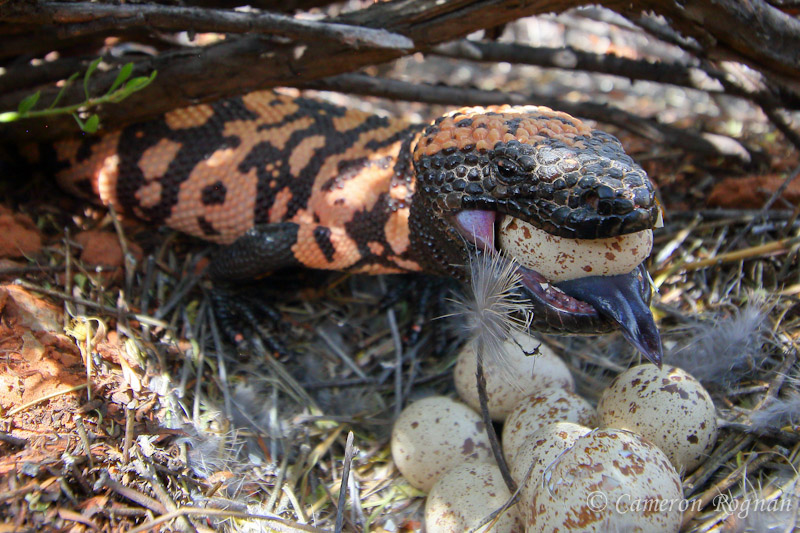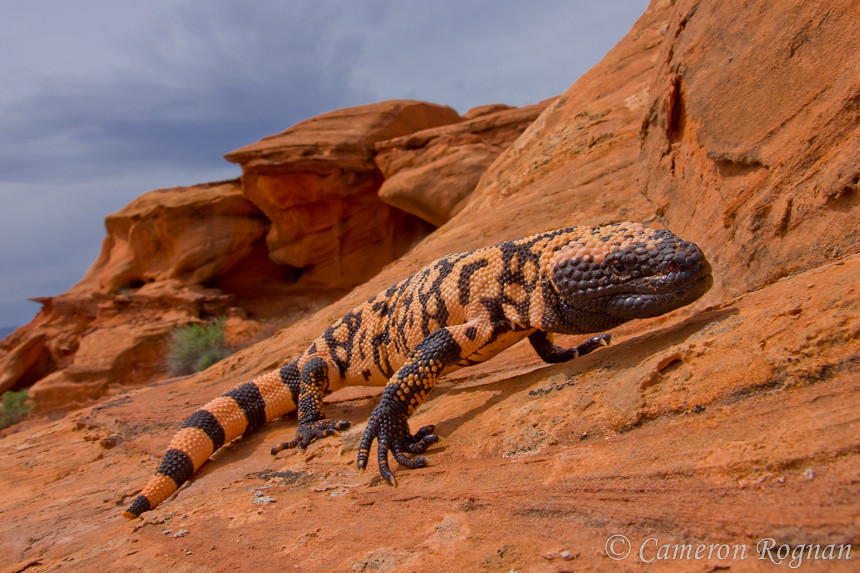
Lizards are innately frightening animals. Cold, scaly, and with calculated stares, these creatures have inspired mythologies, imaginations, and anxieties for thousands of years. That in mind, for me at least, their size has always come as a consolation. Never have I feared stumbling upon a lizard large enough to cause concern (though this might be due to my living in Pennsylvania). Whatever solace came from this rationale, however, was shattered when I learned of the Gila monster (HEE-luh), the largest lizard native to the United States.
To my roommate, an Arizonan, my discovery of this animal was nothing special; but to my girlfriend and I, born and raised on the East Coast, we were blown away (and a little repulsed) by the lizard. Browsing YouTube, we ran across a channel called Brave Wilderness, whose host subjects himself to various venomous bites and stings from across the world. In one of his videos, he inadvertently encounters a Gila monster and, while attempting to capture b-roll, gets bitten on the hand. What caught me off guard the most was the Gila monster’s size. Growing up to 2 feet in size and weighing over 5 pounds, according to National Geographic, this is definitely more lizard than I ever thought I would bargain for in the US. While, the Gila monster is smaller than invasive species such as green iguanas and Nile monitors (coming in around 5 feet in length), it still holds the title of largest native American species.
Found in the southwestern US and northwestern Mexico, Gilas inhabit the Mojave, Sonoran and Chihuahuan deserts. Named after Arizona’s Gila River basin where they were found, they are fairly commonplace in the lives of the people that populate these regions. Because of that, my roommate was not nearly as excited as I was about their simple existence.

One of few, the Gila monster is actually a venomous lizard. The Gila’s venom is a mild neurotoxin which results in extreme pain when bitten. Despite this though, no one has ever died as a result of its bite. Interestingly, the Gila monster doesn’t inject its venom like snakes or other venomous species. Gila monsters latch onto their victims, biting down and chewing, allowing the neurotoxins to run down grooves in their teeth and into the wound. To make this worse, the Gila monster’s bite is no quick process when compared to that of a snake. Gila monster’s will often hold their powerful grip for up to 15 minutes at a time, perfusing as much venom as they can from the glands located in their lower jaw. This neurotoxin is causes pain, swelling, hypotension (low blood pressure), and shock in humans.
Though in possession of such a formidable mechanism, the Gila monster utilizes its venomous abilities for self-defense purposes only, rarely subjecting its prey to its venom. On the menu for the Gila monster are small animals, such as: mammals, birds, and other lizards. That being said, the Gila’s favorite food is something it would never need to envenomate: eggs. Hunting for eggs, this animal has been known to swallow small eggs whole (such as the video of a Gila eating quail eggs on Mental Floss) and crack larger ones, drinking their contents. Gila monsters are known to climb trees in order to reach nests up to 8 feet off the ground. Clearly, this lizard errs on the particular side when it comes to its food.

While their bodies’ camouflage often allows for them to go unseen—boasting black bodies with patterns of pink, orange, or yellow—the Gila monster takes advantage of this trait very rarely throughout the year. A sedentary animal, Gilas spend more than 95% of their life underground, as reported by Mental Floss. Living in “abandoned mammal burrows, pack rat nests, and crevices beneath large rocks”, these lizards only spend about 3-4 weeks above ground. Taking place at night, Gila monsters use this time to hunt.
Incidentally, Gila monsters aren’t hard-pressed to leave the comfort of their subterranean homes due to a knack for long-term planning. Unlike many other lizards, the Gila monster cannot lose and re-grow its tail. However, the tail of the Gila may be used to store fat reserves in. This ability, coupled with their low resting metabolic rate, allows it to survive the duration of a year on as little as 3- 4 meals yearly. Perfect for an animal that surfaces for only 3-4 weeks in a year.
With a bite that packs a punch (an agonizing one), Gilas should be given a wide berth when encountered in nature. That considered, their bite does have one a merit. A synthetic version of a protein found in their saliva is used as a treatment for diabetes in humans. While it wouldn’t do you much good to actively offer one of these guys an arm to bite, they have managed to impact modern medicine positively. All-in-all, the Gila monster’s lifestyle renders it a fairly innocuous species. So long as you give it a respectful distance, one won’t attempt to attack you. Because of this, you should have no trouble taking in the novelty and complexity of this creature, should you ever run into one.
I like gila monster’s because they look cool